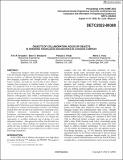| dc.contributor.author | Brubaker, Eric R | |
| dc.contributor.author | Sheppard, Sheri D | |
| dc.contributor.author | Hinds, Pamela J | |
| dc.contributor.author | Yang, Maria C | |
| dc.date.accessioned | 2024-05-09T17:47:10Z | |
| dc.date.available | 2024-05-09T17:47:10Z | |
| dc.date.issued | 2022-08-14 | |
| dc.identifier.uri | https://hdl.handle.net/1721.1/154882 | |
| dc.description.abstract | <jats:title>Abstract</jats:title>
<jats:p>Engineering designers often span knowledge boundaries when developing complex systems but doing so poses challenges because members of different knowledge groups must bridge their language, cognitions, and “thought worlds” to effectively broker, resituate, and make use of each other’s ideas. Objects — ranging from prototypes to kanban boards to value stream maps — are frequently used in cross-functional design practice, but the outcomes associated with such objects appear varied and dependent not only the objects’ characteristics but on how, when, and by whom they are used. This paper describes a two-year inductive ethnographic study within a turbomachinery design company to understand how cross-functional design teams span their knowledge boundaries to advance their designs and design processes. We collected observations of 70 cross-functional meetings and 52 interviews across functional groups during the development of complex turbomachinery products. Our findings include three roles of objects of collaboration: routinizing cross-boundary interaction, translating information across boundaries, and motivating joint negotiation or discovery. We found two prominent outcomes — co-discovery of a design risk, opportunity, or workflow bottleneck and co-design of a joint integrated solution — that appeared to follow from the latter two roles, respectively. These findings are significant because they clarify the roles of objects in cross-boundary design work and suggest ways for designers to more effectively use objects to span knowledge boundaries.</jats:p> | en_US |
| dc.language.iso | en | |
| dc.publisher | American Society of Mechanical Engineers | en_US |
| dc.relation.isversionof | 10.1115/detc2022-89388 | en_US |
| dc.rights | Article is made available in accordance with the publisher's policy and may be subject to US copyright law. Please refer to the publisher's site for terms of use. | en_US |
| dc.source | ASME | en_US |
| dc.title | Objects of Collaboration: Roles of Objects in Spanning Knowledge Boundaries in a Design Company | en_US |
| dc.type | Article | en_US |
| dc.identifier.citation | Brubaker, Eric R, Sheppard, Sheri D, Hinds, Pamela J and Yang, Maria C. 2022. "Objects of Collaboration: Roles of Objects in Spanning Knowledge Boundaries in a Design Company." Volume 6: 34th International Conference on Design Theory and Methodology (DTM). | |
| dc.contributor.department | Massachusetts Institute of Technology. Department of Mechanical Engineering | en_US |
| dc.relation.journal | Volume 6: 34th International Conference on Design Theory and Methodology (DTM) | en_US |
| dc.eprint.version | Final published version | en_US |
| dc.type.uri | http://purl.org/eprint/type/ConferencePaper | en_US |
| eprint.status | http://purl.org/eprint/status/NonPeerReviewed | en_US |
| dc.date.updated | 2024-05-09T17:43:18Z | |
| dspace.orderedauthors | Brubaker, ER; Sheppard, SD; Hinds, PJ; Yang, MC | en_US |
| dspace.date.submission | 2024-05-09T17:43:20Z | |
| mit.license | PUBLISHER_POLICY | |
| mit.metadata.status | Authority Work and Publication Information Needed | en_US |
